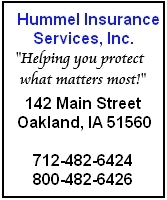Feedlot Operator talks to youth about beef selection process
February 27th, 2012 by Ric Hanson
A custom feedlot owner operator from Adams County told attendees at Sunday afternoon’s Rolling Hills Heifer Project banquet and awards program in Atlantic, that when he purchases feeder cattle, whether it be from auctions or through private sale, he takes a lot of time asking questions about the animals’ health, quality and when, where, and how he will harvest and market the animals. Todd Drake, who owns Nodaway Valley Feeders, in Nodaway, said his decision is ultimately impacted by how healthy the cow is. He says he likes to purchase cattle which come directly from the mother cow, complete with a round-to-modified live vaccine, about three-weeks prior to shipment.
Drake says cattle which are weaned have more value to him, depending on the time of the year. He says he also likes to buy cattle which are on a “non-starch” diet, or those who eat very little corn. He says he doesn’t want the cattle to be “huge” before he buys them. He recommends forage based diets for the animals. As for quality, Drake says the types of animals that bring in the most money at his feedlots, are those with capacity, and spring of rib depth. He says he wants cattle “That can consume a lot of dry matter.” Cattle “With some width between their front legs and plenty of spring of rib,” appear to be their lowest cost of gains or best dry matter conversions.
Drake says it’ important for the animal to have some size. He says they like to have steers that finish out at around 1,350-pounds, and heifers that finish at 1,250-pounds. Drake says he has not preference when it comes to color and breed of the cow, but the bottom-line on closeouts is, that those animals with at least three-quarters English blood in them provide the best closeouts. That would include those animals bred to Charolais, Simmental, and some exotics. The “half-and-half” bloods…such as a Charolais bred to an Angus cow…don’t work as well, he says, when it comes to dry matter conversion.
Drake says he spends a lot of time on marketing the animals he gets into his feedlot, and get them harvested before it gets too hot, or late in the fall. He left the young people at Sunday’s meeting with a phrase to remember when purchasing their own cows in the future. He says great calves to buy should grade about 70% choice and about 70% one and two yield grades. Many of the animals he purchases come from Florida, Montana, the Sand Hills of Nebraska and elsewhere, but the majority comes from northern Missouri and southern Iowa.





